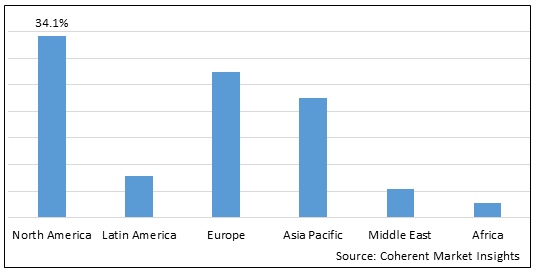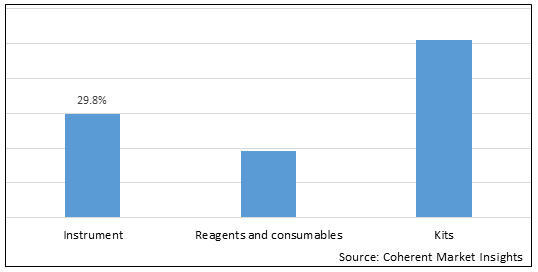Sperm Count Test Market is estimated to be valued at USD 2,473.8 Mn in 2025 and is expected to reach USD 3,844.3 Mn in 2032, exhibiting a compound annual growth rate (CAGR) of 6.5% from 2025 to 2032. Sperm count tests are used to evaluate semen samples to determine the sperm concentration and motility. These tests assist in diagnosing male infertility issues. Growing incidence of infertility and rising awareness about fertility testing are the key factors driving the global sperm count test market.
Global Sperm Count Test Market Regional Insights
- North America is expected to be the largest market for sperm count test market during the forecast period, which is expected to account for 34.1% of the market share in 2025. The market growth in North America is due to the high awareness regarding fertility, access to advanced healthcare infrastructure, and supportive government policies.
- The Europe market is expected to be the second-largest market for sperm count test market, which is expected to account for over 27.4% of the market share in 2025. The market growth in Europe is due to the rising focus on male infertility screening and increasing medical tourism for fertility treatments.
- The Asia Pacific market is expected to be the fastest-growing market sperm count test market, with a CAGR of over 8.5% during the forecast period. The market growth in Asia Pacific is due to growing adoption of sperm tests, large patient pool, and improving healthcare expenditure.
Figure 1. Global Sperm Count Test Market Share (%), By Region, 2025

To learn more about this report, Download Free Sample
Analysts’ Views on Global Sperm Count Test Market:
The sperm count test market is driven by growing prevalence of male infertility which is due to factors like lifestyle changes, environmental issues, and delayed parenthood, prompting an increased need for fertility assessments. Advancements in diagnostic technologies and an evolving understanding of male reproductive health contribute to the market's growth.
However, factors such as the high cost of advanced tests, limited insurance coverage for fertility testing, and cultural stigmas surrounding male fertility issues, are limiting the growth of the global sperm count test market. Accuracy variations among testing methods and the lack of standardization presents challenges for market growth.
Emerging trends in the sperm count test market involve the rising demand for at-home testing kits and the integration of artificial intelligence (AI) and digital health solutions for fertility assessments. These trends aim to enhance accessibility, affordability, and privacy, thereby catering to individuals' preferences for self-testing and remote healthcare services. Moreover, the shift toward comprehensive male fertility assessments beyond just sperm count, incorporating sperm quality and functionality evaluation, represents a progressive trend in the market.
To overcome restraints, standardization and accuracy improvements in testing methods, along with increased awareness and education about male fertility, are crucial. Furthermore, addressing the cost and insurance coverage issues and reducing social stigma are essential for wider market acceptance. Embracing technological advancements and catering to the demand for convenient, at-home testing solutions can drive the market's future growth by providing accessible, accurate, and comprehensive male fertility assessments.
Global Sperm Count Test Market Drivers:
- Rising incidence of infertility and importance of early diagnosis: Rising incidence of infertility among couples globally is a major factor driving the sperm count test market. According to the estimates, 8-12% of couples face difficulties in conceiving. Male infertility accounts for 20-30% of infertility cases. Sperm count tests assist in early diagnosis of potential fertility issues in males. They provide vital insights about sperm count and motility to help diagnose male infertility factors. The growing importance of early testing and proactive fertility management is expected to increase adoption of sperm count tests in future.
- Increasing availability and awareness of at-home sperm test kits: Growing availability of easy-to-use and accurate at-home sperm count testing kits is driving the market growth. Companies are focusing on developing sperm count kits that are designed for convenient in-home use. These kits allow men to test sperm counts privately in the comfort of their homes. Direct-to-consumer fertility test kits by companies like Medical Electronic Systems, ContraVac, Inc., and others have improved awareness and adoption of sperm count testing among men. Their discreet and affordable at-home testing capabilities make them appealing to customers. Rising awareness and demand for at-home sperm tests provides growth opportunities for the global sperm count test market.
- Advancements in sperm counting devices and methods: Integration of advanced technologies such as microfluidics, lab-on-chip, and AI in sperm analysis devices is enhancing speed, efficiency, and accuracy. Companies are developing automated sperm counting systems and computer-aided sperm analysis (CASA) systems integrated with AI algorithms to perform rapid semen analysis and detect abnormalities. For instance, Microptic, a Spain-based company in the field of research, development, distribution and installation of automatic diagnostic systems, has CASA system - SCA CASA system which can assess sperm concentration and motility in less than 1 minute. Such advancements are driving adoption and providing growth opportunities.
Global Sperm Count Test Market Opportunities:
- Significant growth potential in emerging economies: Emerging economies present significant growth opportunities for sperm count test market due to the large population base, rising infertility rates, and improving healthcare expenditure. Countries like China, Brazil, Mexico, and India have high infertility rates ranging from 10-15%. The low awareness, social stigma, and high cost have limited adoption of sperm tests. Companies can focus on improving awareness and access to cost-effective tests in these untapped markets. Local partnerships, targeted marketing, and region-specific products can help tap the high growth potential.
- Growing demand for fertility treatments and sperm banks: Rising number of couples opting for fertility treatments like In vitro fertilization (IVF), Intrauterine insemination (IUI), and growth in fertility tourism provides opportunities for sperm count testing. Sperm count assessment is routinely required before fertility procedures. Increasing number of fertility clinics and rising procedures will drive testing volumes. Similarly, the growing number of sperm banks globally will also aid the market growth. Increasing social acceptance, innovations like vitrification, and need for donor sperm for IVF procedures will drive the market growth.
- Increasing applications of sperm function testing: Advancements in biomarkers and omics platforms have expanded the capabilities of sperm function testing beyond sperm count. Tests providing insights about DNA fragmentation, oxidative stress, apoptosis, ATP levels, sperm proteome, and others allow comprehensive assessment of male reproductive health and disorders. Their ability to provide actionable insights about lifestyle changes and treatment interventions presents growth opportunities. Increasing research and development (R&D) and clinical validation will support adoption among clinicians and patients.
- Rise of fertility and health tracking apps: The emerging popularity of fertility tracking mobile apps provides opportunities for the integration of sperm testing and analysis. Applications allowing women to track ovulation, menstrual cycles, and fertility hormones have gained immense popularity. Rise of male fertility tracking apps will also propel at-home sperm testing. Partnerships with application developers can help engage consumers with holistic trackers, remote analysis by clinicians and personalized recommendations to improve sperm parameters.
Sperm Count Test Market Report Coverage
| Report Coverage | Details | ||
|---|---|---|---|
| Base Year: | 2024 | Market Size in 2025: | USD 2,473.8 Mn |
| Historical Data for: | 2020 To 2024 | Forecast Period: | 2025 To 2032 |
| Forecast Period 2025 to 2032 CAGR: | 6.5% | 2032 Value Projection: | USD 3,844.3 Mn |
| Geographies covered: |
|
||
| Segments covered: |
|
||
| Companies covered: |
Medical Electronic Systems, Sandstone Diagnostics, CooperSurgical, Inc., Hamilton Thorne, MICROPTIC, ContraVac, Inc., DNA Diagnostics Center, bioMérieux SA, Mojo, Thermo Fisher Scientific Inc., and Ro |
||
| Growth Drivers: |
|
||
| Restraints & Challenges: |
|
||
Uncover macros and micros vetted on 75+ parameters: Get instant access to report
Global Sperm Count Test Market Trends:
- Increasing consolidation activities among market players: Global sperm count test market has witnessed increasing consolidation over the past decade. Established market players are focused on inorganic strategies like acquisitions and partnerships to expand product portfolios, enter new markets and enhance distribution capabilities. For instance, in June 2021, DNA Diagnostics Center, a U.K.-based provider of DNA and paternity testing, announced acquisition by Eurofins, a publicly-traded global laboratory testing business. DNA Diagnostics Center is well known for leading consumer brands including sperm count test, SpermCheck.
- Growing adoption of advanced automated sperm analyzers: Advanced automated sperm quality analyzers integrated with AI, multi-parameter analysis, and techniques like CASA (computer-assisted sperm analysis) are gaining adoption. They allow rapid and standardized semen analysis by minimizing errors and variability. Companies like Medical Electronic Systems, Vitrolife, and Microptic offer automated sperm analyzers for clinical use. Their ability to assess multiple sperm parameters helps clinicians diagnose male infertility factors accurately. Automation aids workflow efficiency. The continued product development will support adoption among labs and clinics.
Sperm Count Test Market Restraints:
- High costs of testing devices and low reimbursements: The high costs of technologically advanced automated sperm counters and semen analysis systems leads to significant capital investments for procurement. Their high cost of ownership limits purchase and adoption among small clinics and hospitals with budget constraints Variability in insurance coverage and reimbursement for fertility testing across regions also limits affordability. Low reimbursements in emerging economies restrict the market growth to an extent.
- Stigma associated with infertility and semen analysis: The stigma of embarrassment and privacy concerns are associated with fertility testing among men, which remains a key market challenge. Semen analysis requires masturbation at a clinic, which many men are uncomfortable to perform at the clinics. Social stigma regarding sexual health and conservative attitudes about male infertility can impact willingness to undergo testing in several countries. Lack of dialogue about fertility issues and low awareness limits open discussions. Though initiatives around men's health help, considerable efforts are needed to normalize testing.
Counterbalance: The social stigma associated with fertility testing among men needs to be removed with proper awareness programs and thereby normalize the process of testing.
Recent Developments
New product launches
- In January 2023, Jack Fertility, a new healthtech startup, launch its male fertility test. The test would allow men to conveniently take a sperm sample at home and submit it to a lab for testing, thus eliminating the need for uncomfortable and inconvenient in-person clinic sessions.
Acquisition and partnerships
- In March 2022, a direct-to-customer healthcare company, Ro, announced acquisition of Dadi, a fertility company specializing in the facilitation of sperm testing, analysis, and storage.
Figure 2. Global Sperm Count Test Market Share (%), By Product type, 2025

To learn more about this report, Download Free Sample
Top Companies in Global Sperm Count Test Market
- Medical Electronic Systems
- Sandstone Diagnostics
- CooperSurgical, Inc.
- Hamilton Thorne
- MICROPTIC
- ContraVac, Inc.
- DNA Diagnostics Center
- bioMérieux SA
- Mojo
- Thermo Fisher Scientific Inc.
- Ro
Definition: The sperm count test market refers to the industry and companies that are involved in manufacturing and supplying products, equipment and services which are used to evaluate and test semen samples to determine sperm count and motility. It includes products like sperm count test kits, instruments, and software used by hospitals, clinics, cryobanks, and home care settings to assess male fertility. The sperm analysis aids in diagnosing potential causes of male infertility.
Share
Share
About Author
Manisha Vibhute is a consultant with over 5 years of experience in market research and consulting. With a strong understanding of market dynamics, Manisha assists clients in developing effective market access strategies. She helps medical device companies navigate pricing, reimbursement, and regulatory pathways to ensure successful product launches.
Missing comfort of reading report in your local language? Find your preferred language :
Transform your Strategy with Exclusive Trending Reports :
Frequently Asked Questions
Select a License Type
EXISTING CLIENTELE
Joining thousands of companies around the world committed to making the Excellent Business Solutions.
View All Our Clients




